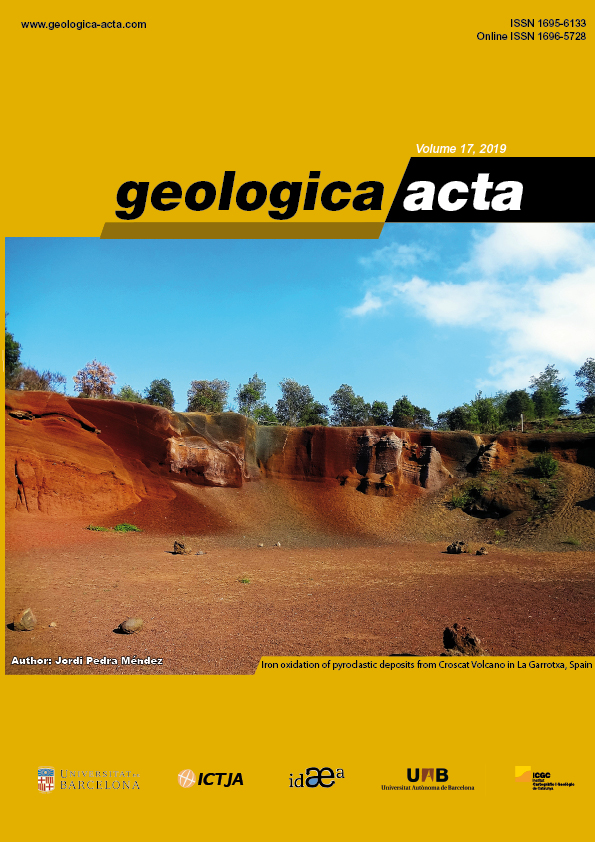Evaluation of the Relative Tectonic Activity of the Adıyaman fault within the Arabian-Anatolian plate boundary (eastern Turkey)
DOI:
https://doi.org/10.1344/GeologicaActa2019.17.6Keywords:
Tectonic geomorphology, Geomorphic indices, Adıyaman strike-slip fault, Eastern TurkeyAbstract
The left-lateral strike-slip Adıyaman fault is located in eastern Turkey within the plate boundary deformation zone between Arabia and Anatolia. The Adıyaman fault is a major splay from the East Anatolian Fault (EAF), one of the most important tectonic structures in the Eastern Mediterranean region. These faults are consequence of the collision between the Arabian and Anatolian plates and the resulting westward tectonic escape of Anatolia. Although the EAF has been intensively studied since its discovery in the late 1960s, little is known about the Adıyaman fault and its tectonic activity. In this study, we extract geomorphic indices including mountain-front sinuosity (Smf), valley floor width-to-height ratio (Vf), stream length-gradient (SL), catchment Asymmetry Factor (AF) and hypsometric integrals and curves (HI and HC) to evaluate the relative tectonic activity of the Adıyaman fault. These three geomorphic indices (AF, HI, and HC) are averaged to define an index for Relative Tectonic Activity (RTA) that allows the Adıyaman fault to be divided into categories of low, moderate and high RTA. The results confirm that the Adıyaman fault is an active fault with high to moderate Quaternary tectonic activity. However, this fault is of minor importance on accommodating plate boundary deformation, as evidenced by the recent crustal motions determined by GPS studies. Nevertheless, it is worthwhile to note that the Adıyaman fault still poses a significant seismic hazard for the region despite its relatively moderate tectonic activity.
References
Aksoy, E., İnceöz, M., Koçyiğit, A., 2007. Lake Hazar Basin: a Negative Flower Structure on the East Anatolian Fault System
(EAFS), SE Turkey. Turkish Journal of Earth Science, 16(3), 319-338.
Aktuğ, B., Özener, H., Dogru, A., Sabuncu, A., Turgut, B., Halicioglu, K., Yilmaz, O., Havazli, E., 2016. Slip rates and seismic potential on the East Anatolian Fault System using an improved GPS velocity field. Journal of Geodynamics, 94-95, 1-12.
Alipoor, R., Poorkermani, M., Zare, M., El Hamdouni, R., 2011. Active tectonic assessment around Rudbar Lorestan dam site,
High Zagros Belt (SW of Iran). Geomorphology, 128(1-2), 1-14.
Allen, C.R., 1969. Active Faulting in Northern Turkey. Division of Geological Science Contribution, California Institute of Technology Contribution, 1577, 32pp.
Ambraseys, N.N., 1989. Temporary seismic quiescence: SE Turkey. Geophysics Journal International, 96(2), 411-431.
Arpat, E., Şaroğlu, F., 1972. The East Anatolian Fault System: thoughts on its development. The Mineral Research and Exploration Institute of Turkey (MTA), 78, 33-39.
Azor, A., Keller, E.A., Yeats, R.S., 2002. Geomorphic indicators of active fold growth: South Mountain–Oak Ridge anticline,
Ventura basin, southern California. Geological Society of America Bulletin, 114(6), 745-753.
Barka, A.A., Şaroğlu, F., Güner, Y., 1983. Horasan-Narman depremi ve bu depremin Doğu Anadolu neotektonigindeki yeri. Yeryuvan Ve Insan, 8(3), 16-21. [In Turkish with English abstract] [Available in: https://www.jmo.org.tr/resimler/ekler/fcf34635f905065_ek.pdf?dergi=YERYUVARI%20VE%20%DDNSAN]
Bozkurt, E., 2001. Neotectonics of Turkey – a synthesis. Geodinamica Acta, 14(1-3), 3-30.
Bull, W.B., McFadden, L.D., 1977. Tectonic geomorphology north and south of the Garlock Fault, California. In: Doehering,
D.O. (ed.). Geomorphology of Arid Regions. Binghamton, State University of new York, proceedings of the 8th Annual Geomorphology Symposium Proceedings, 115-138.
Bull, W.B., 2007. Tectonic Geomorphology of Mountains: A new Approach to Paleoseismology. Hoboken, New Jersey, USA,
Wiley - Blackwell, 328pp.
Bulut, F., Bohnhoff, M., Eken, T., Janssen, C., Kılıç, T., Dersen, G., 2012. The East Anatolian Fault Zone: Seismotectonic setting and spatiotemporal characteristics of seismicity based on precise earthquake locations. Journal of Geophysical Research, 117(B7), 1-16.
Canıtez, N., Üçer B., 1967. A catalogue of focal mechanism diagrams for Turkey and adjoining areas. Istanbul Technical University Arz. Fizigi Enstitusu, 25.
Chen, Y.C., Sung, Q., Cheng, K.-Y., 2003. Along-strike variations of morphotectonic features in the Western Foothills of Taiwan: tectonic implications based on stream-gradient and hypsometric analysis. Geomorphology, 56(1-2), 109-137.
Ciccacci, S., D’Alessandro, L., Fredi, P., Lupia-Palmeri, E., 1992. Relations between morphometric characteristics and denudational processes in some drainage basins of Italy. Zeitschfirt für Geomorphologie, 36, 53-67.
D’Alessandro, L., Del Monte, M., Fredi, P., Lupia-Palmeri, E., Peppoloni, S., 1999. Hypsometric Analysis in the Study of Italian Drainage Basin Morphoevolution. Transactions, Japanese Geomorphological Union, 20(3), 187-202.
Dewey, J.F., Hempton, M.R., Kidd, W.S.F., Şaroğlu, F., Şengör, A.M.C., 1986. Shortening of continental lithosphere: the neotectonics of Eastern Anatolia-a young collision zone. In: Coward, M.O., Ries, A.C. (eds.). Collisional Tectonics. Geological Society, London, Special Publication, 19(1) 3-36.
Dumont, J.F., Santana, E., Vilema, W., 2005. Morphologic evidence of active motion of the Zambapala Fault, Gulf of Guayaquil (Ecuador). Geomorphology, 65(3-4), 223-239.
El Hamdouni, R., Irigaray, C., Fernández, T., Chacón, J., Keller, E.A., 2008. Assessment of relative active tectonics, southwest border of the Sierra Nevada (southern Spain). Geomorphology, 96(1-2), 150-173.
Eyidoğan, H., Nalbant S.S., Barka A.A., King G.C.P., 1999. Static stress changes induced by the 1924 Pasinler (M=6.8) and 1983 Horasan-Narrnan (M=6.8) earthquakes, Northeastern Turkey. Terra Nova, 11(1), 38-44.
Farr, T.G., Rosen, P.A., Caro, E., Crippen, R., Duren, R., Hensley, S., Kobrick, M., Paller, M., Rodriguez, E., Roth, L., Seal, D., Shaffer, S., Shimada, J., Umland, J., Werner, M., Oskin, M., Burbank, D., Alsdorf, D., 2007. The Shuttle Radar Topography Mission. Reviews of Geophysics, 45(2), 1-33.
Fielding, E.J., Lundgren, P.R., Taymaz, T., Yolsal-Çevikbilen, S., Owen, S.E., 2013. Fault-slip sourcemodels for the 2011 M7.1 Van earthquake in Turkey from SAR interferometry, pixel offset tracking, GPS and seismic waveform analysis. Seismological Research Letters, 84(4), 579-593.
Frank, P., Claudio, B., Ryan ,M., Kellen, G., Alese, K., 2011. Tectonic geomorphology and Earth Scope in Eastern North America. Abstract. Minneapolis, GSA Annual meeting in Minneapolis, 9-12 October, 43, 5, 363.
Giaconia, F., Booth-Rea, G., Martínez-Martínez, J.M., Azañón, J.M., Pérez-Peña, J.V., 2012. Geomorphic analysis of the Sierra Cabrera, an active pop-up in the constrictional domain of conjugate strike-slip faults: The Palomares and Polopos fault zones (eastern Betics, SE Spain). Tectonophysics, 580, 27-42.
Giamboni, M., Wetzel, A., Schneider, B., 2005. Geomorphic response of alluvial rivers to active tectonics: example from the southern Rhinegraben. Australian Journal of Earth Sciences, 97, 24-37.
Gordon, R.G., 1998. The plate tectonic approximation: plate nonrigidity, diffuse plate boundaries, and global plate reconstructions. Annual review of Earth and Planteary Sciences, 26(1), 615-642.
Hack, J.T., 1973. Stream-profiles analysis and stream-gradient index. Journal of Research of the U.S. Geological Survey, 1(4), 421-429.
Hare, P.H., Gardner, T.W., 1985. Geomorphic indicators of vertical neotectonism along the converging plate margins, Nicoya
Peninsula, Costa Rica. In: Morisawa, M., Hack, J.T. (eds.). Allen and Unwin, Boston, MA, Tectonic Geomorphology, 4, 75-104.
Hempton, M.R., Dewey, J.F., Şaroğlu, F., 1981. The East Anatolian transform fault: along strike variations in geometry and behaviour. EOS Transactions American Geophysical Union, 62, 393.
Hempton, M.R., 1987. Constraints on Arabian Plate motion and extensitonal history of the Red Sea. Tectonics, 6(6), 687-705.
Herece, E., 2008. Atlas of the East Anatolian Fault, General Directorate of Mineral Research and Exploration (MTA), Special Publication Series, 13.
Keller, E.A., Printer, N., 2002. Active Tectonics. Earthquakes, Uplift and Landscape. New Jersey, Prentice Hall, 362pp.
Khalifa, A., Çakir, Z., Owen L.A., Kaya, Ş., 2018. Morphotectonic analysis of the East Anatolian Fault, Turkey. Turkish Journal of Earth Sciences, 27, 110-126.
Lifton, N.A., Chase, C.G., 1992. Tectonic, climatic and lithologic influences on landscape fractal dimension and hypsometry:
implications for landscape evolution in the San Gabriel Mountains, California. Geomorphology, 5(1-2), 77-114.
Mahmood, S.A., Gloaguen, R., 2012. Appraisal of active tectonics in Hindu Kush: Insights from DEM derived geomorphic
indices and drainage analysis. Geoscience Frontiers, 3(4), 407-428.
Matoš, B., Pérez-Peña, J. V., Tomljenovi, B., 2016. Landscape response to recent tectonic deformation in the SW Pannonian
Basin: Evidences from DEM-based morphometric analysis of the Bilogora Mt. area, NE Croatia. Geomorphology, 263, 132-155.
Mayer, L., 1986. Tectonic Geomorphology of Escarpments and Mountain fronts. Active Tectonics, 7, 125-135.
McKenzie, D., 1972. Active Tectonics of the Mediterranean Region. Geophysical Journal International, 30(2), 109-185. DOI: 10.1111/j.1365-246X.1972.tb02351.x
Molin, P., Pazzaglia, F.J., Dramis, F., 2004. Geomorphic expression of active tectonics in a rapidly-deforming forearc, Sila massif, Calabria, southern Italy. American Journal of Science, 304(7), 559-589.
Necea, D., Fielitz, W., Matenco, L., 2005. Late Pliocene–Quaternary tectonics in the frontal part of the SE Carpathians: Insights from tectonic geomorphology. Tectonophysics, 410(1-4), 137-156.
Ohmori, H., 1993. Changes in the hypsometric curve through mountain building resulting from concurrent tectonics and
denudation. Geomorphology, 8(4), 263-277.
Pérez-Peña, J.V., Azor, A., Azañón, J.M., Keller, E.A., 2010. Active tectonics in the Sierra Nevada (Betic Cordillera, SE Spain): Insights from geomorphic indices and drainage pattern analysis. Geomorphology, 119(1-2), 74-87.
Perinçek, D., Çemen, İ., 1990. The structural relationship between the East Anatolian and Dead Sea fault zones in Southeastern Turkey. Tectonophysics, 172(3-4), 331-340.
Reilinger, R., McClusky, S., Vernant, P., Lawrence, S., Ergintav, S., Cakmak, R., Ozener, H., Kadirov, F., Guliev, I., Stepanyan, R., Nadariya, M., Hahubia, G., Salah, M., Sakr, K., ArRajehi, A., Paradissis, D., Al-Aydrus, A., Prilepin, M., Guseva, T., Evren, E., Dmitrotsa, A., Filikov, S.V., Gomez, F., Al-Ghazzi, R., Gebran, K., 2006. GPS constraints on continental deformation in the Africa-Arabia–Eurasia continental collision zone and implications for dynamics of plate interactions. Journal of Geophysical Research Solid Earth, 111(B5), 1-26.
Rockwell, T.K., Keller, E.A., Johnson, D.L., 1984. Tectonic geomorphology of alluvial fans and mountain fronts near Ventura, California. In: Morisawa, M., Hack, J.T. (eds.). Tectonic Geomorphology. Allen and Unwin, Boston, MA, Proceedings of the 15th Annual Geomorphology Symposium, 183-207.
Selçuk, S.A., 2016. Evaluation of the relative tectonic activity in the eastern Lake Van basin, East Turkey. Geomorphology,
, 9-21.
Selby, M.J., 1980. A rock strength classification for geomorphic purposes: with tests from Antarctica and New Zealand. Z.
Geomorphlogi, 24, 21-51.
Selim, H.H., Tüysüz, O., Karakaş, A., Taş, K.Ö., 2013. Morphotectonic evidence from the southern branch of the North Anatolian Fault (NAF) and basins of the south Marmara sub-region, NW Turkey. Quaternary International, 292, 176-192.
Silva, P.G., Goy, J.L., Zazo, C., Bardajı, T., 2003. Fault-generated mountain fronts in southeast Spain: geomorphologic assessment of tectonic and seismic activity. Geomorphology, 50(1-3), 203-225.
Strahler, A.N., 1952. Hypsometric (area-altitude) analysis of erosional topography. The Geological Society of America Bulletin, 63(11), 1117-1142.
Şaroğlu F., Emre Ö., Kuşçu İ., 1992. Active Fault Map of Turkey. General Directorate of Mineral and Research Exploration of
Turkey (MTA) Publication, Ankara, Turkey.
Şengör, A.M.C., Görür, N., Şaroğlu, F., 1985. Strike-slip faulting and related basin formation in zones of tectonic escape: Turkey as a case study. In: Biddle, K.T., Christie-Slick N. (eds.). Strike-slip Faulting and Basin Formation. Society of Economic Paleontologist and Mineralogists, Tulsa, Special Publication, 37, 227-264.
Şengör, A.M.C., Tüysüz, O., İmren, C., Sakınç, M., Eyidoğan, H., Görür, N., Le Pichon, X., Rangin, C., 2005 The North Anatolian Fault: A new look. Annual review of earth and planetary science, 33, 37-112.
Taymaz, T., Jackson, J., McKenzie, D.P., 1991. Active tectonics of north and central Aegean Sea. Geophysical Journal International, 106(2), 433-490.
Toksöz, M.N., Guenette, M., Gülen, L., Keough, G., Pulli, J.J., Sav, H., Olguner, A., 1983. 30 Ekim 1983 Narman-Horasan depreminin kaynak mekaniszmasi Yeryuvan Ve Insan 8(3), 47-52 [In Turkish with English abstract][Available in: https://www.jmo.org.tr/resimler/ekler/a7bd93c6f3112cb_ek.pdf?dergi=YERYUVARI%20VE%20%DDNSAN]
Tsodoulos, I.M., Koukouvelas, I.K., Pavlides, S., 2008. Tectonic geomorphology of the easternmost extension of the Gulf of
Corinth (Beotia, Central Greece). Tectonophysics, 453(1-4), 211-232.
Ul-Hadi, S., Shuhab, D.K., Lewis, A.O., Abdul, S.K., 2013. Geomorphic response to an active transpressive regime: a case study along the Chaman strike-slip fault, western Pakistan. Earth Surface Processes and Landforms, 38(3), 250-264.
Wells, S.G., Bullard, T.F., Menges, C.M., Dark, P.G., Keras, P.A., Kelson, K.I., Ritter, J.B., Wesling, J.R., 1988. Regional variations in tectonic geomorphology along a segmented convergent plate boundary pacific coast of Costa Rica. Geomorphology, 1(3), 239-265.
Westaway, R., 1994. Present-day kinematics of the Middle East and eastern Mediterranean. Journal of Geophysical Research, 99(B6), 12071-12090.
Willgoose, G., 1994. A physical explanation for an observed areaslope–elevation relationship for catchments with declining
relief. Water Resources Research, 30(2), 151-159.
Willgoose, G., Hancock, G., 1998. Revisiting the hypsometric curve as an indicator of form and process in transport-limited
catchment. Earth Surface Processes and Landforms, 23(7), 611-623.
Yıldırım, C., 2014. Relative tectonic activity assessment of the Tuz Gölü Fault Zone; Central Anatolia, Turkey. Tectonophysics, 630, 183-192.
Downloads
Published
Issue
Section
License
Copyright (c) 2019 Geologica Acta

This work is licensed under a Creative Commons Attribution-ShareAlike 4.0 International License.
Copyright
Geologica Acta is the property of the UB, GEO3BCN, IDAEA and UAB. Geologica Acta must be cited for any partial or full reproduction. Papers are distributed under the Attribution-Share Alike Creative Commons License. This license allows anyone to reproduce and disseminate the content of the journal and even make derivative works crediting authorship and provenance and distributing possible derivative works under the same or an equivalent license.
Author Rights
Authors retain the copyright on their papers and are authorized to post them on their own web pages or institutional repositories. The copyright was retained by the journal from the year 2003 until 2009. In all cases, the complete citation and a link to the Digital Object Identifier (DOI) of the article must be included.
The authors can use excerpts or reproduce illustrations of their papers in other works without prior permission from Geologica Acta provided the source of the paper including the complete citation is fully acknowledged.




